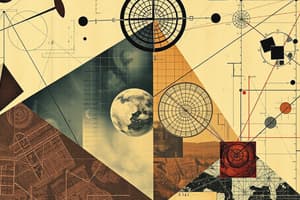Podcast
Questions and Answers
In which field is mathematics used for modeling economic phenomena and predicting outcomes?
In which field is mathematics used for modeling economic phenomena and predicting outcomes?
- Medicine
- Physics
- Engineering
- Economics (correct)
Which application of mathematics is primarily concerned with diagnosing illnesses and calculating drug dosages?
Which application of mathematics is primarily concerned with diagnosing illnesses and calculating drug dosages?
- Engineering
- Finance
- Medicine (correct)
- Computer Science
What is the first step in the problem-solving process as outlined in the applications of mathematics?
What is the first step in the problem-solving process as outlined in the applications of mathematics?
- Modeling (correct)
- Strategies
- Evaluation
- Analysis
Which of the following fields utilizes mathematics for design and analysis in various engineering disciplines?
Which of the following fields utilizes mathematics for design and analysis in various engineering disciplines?
In the context of problem-solving, what does evaluation refer to?
In the context of problem-solving, what does evaluation refer to?
What does geometry primarily focus on?
What does geometry primarily focus on?
Which branch of mathematics uses limits, derivatives, and integrals?
Which branch of mathematics uses limits, derivatives, and integrals?
What type of operations can be performed on sets?
What type of operations can be performed on sets?
Which of the following best describes a function?
Which of the following best describes a function?
Inequalities are used to show relationships using which symbols?
Inequalities are used to show relationships using which symbols?
What is the primary focus of statistics in mathematics?
What is the primary focus of statistics in mathematics?
Which of the following operations is NOT one of the four fundamental operations?
Which of the following operations is NOT one of the four fundamental operations?
What is mathematical proof intended to establish?
What is mathematical proof intended to establish?
Flashcards
Mathematics in Physics
Mathematics in Physics
The use of mathematics to understand and predict how objects move, interact, and change over time.
Mathematics in Engineering
Mathematics in Engineering
Applying mathematical principles for designing, analyzing, and solving problems in various engineering fields.
Mathematics in Computer Science
Mathematics in Computer Science
The foundation of algorithms, data structures, and software development, enabling efficient processing and problem-solving.
Mathematics in Economics
Mathematics in Economics
Signup and view all the flashcards
Mathematics in Medicine
Mathematics in Medicine
Signup and view all the flashcards
What is Arithmetic?
What is Arithmetic?
Signup and view all the flashcards
What is Geometry?
What is Geometry?
Signup and view all the flashcards
What is Statistics?
What is Statistics?
Signup and view all the flashcards
What is Algebra?
What is Algebra?
Signup and view all the flashcards
What is Calculus?
What is Calculus?
Signup and view all the flashcards
What is Probability?
What is Probability?
Signup and view all the flashcards
What is a Set?
What is a Set?
Signup and view all the flashcards
What is a Function?
What is a Function?
Signup and view all the flashcards
Study Notes
Key Branches of Mathematics
- Arithmetic: Focuses on basic operations like addition, subtraction, multiplication, and division. It forms the foundation for more advanced mathematical concepts.
- Algebra: Introduces variables and explores relationships between quantities. It uses symbols to represent unknown values and allows for the solution of equations and inequalities.
- Geometry: Deals with shapes, sizes, and positions of objects in space. It encompasses topics such as lines, angles, triangles, circles, and other geometric figures.
- Calculus: Focuses on change and rates of change. It uses limits, derivatives, and integrals to analyze functions and solve problems involving motion, optimization, and other real-world phenomena.
- Statistics: Involves collecting, organizing, analyzing, interpreting, and presenting data. It uses methods to summarize and draw conclusions from numerical data.
- Probability: Measures the likelihood of events occurring. It uses mathematical tools to quantify the chance of different outcomes.
Fundamental Concepts
- Sets: Collections of objects or elements. Operations like union, intersection, and complement are performed on sets.
- Numbers: Real numbers, integers, rational numbers, irrational numbers, natural numbers, and complex numbers are explored, along with their properties and relationships.
- Functions: Represent relationships between inputs and outputs. Different types of functions exist, including linear, quadratic, exponential, trigonometric, etc., each with its own properties and uses.
- Equations: Statements of equality between expressions. Solving equations for unknown variables is a central theme in algebra.
- Inequalities: Statements that show the relationship between expressions using symbols like <, >, ≤, ≥. Solving inequalities involves finding the values that satisfy the relationship.
Fundamental Operations
- Addition: Combining values together.
- Subtraction: Taking away a value from another.
- Multiplication: Repeated addition of a value.
- Division: Finding how many times one value goes into another.
Mathematical Reasoning
- Logic: The process of using reasoning to construct sound arguments. Key concepts like deduction and induction play roles in understanding logical structures.
- Proof: Showing that a statement is always true using logical arguments and established mathematical facts. Different types of proof exist, each with a specific method.
Applications of Mathematics
- Physics: Used to describe motion, forces, and energy.
- Engineering: Used for design, analysis, and problem-solving in diverse fields like civil and mechanical engineering.
- Computer Science: Fundamental to algorithms, data structures, and software development.
- Economics: Used to model economic phenomena and predict outcomes.
- Finance: Useful for calculating interest, risk analysis, and investment strategies.
- Medicine: Used in various applications such as diagnostics, drug dosage calculations, etc.
Problem Solving
- Modeling: Abstracting a real-world problem into a mathematical representation.
- Analysis: Breaking down a problem into smaller, manageable parts.
- Strategies: Using relevant mathematical concepts to find and implement solutions, e.g., using diagrams, equations, or logical reasoning.
- Evaluation: Assessing the validity and applicability of solutions.
Studying That Suits You
Use AI to generate personalized quizzes and flashcards to suit your learning preferences.
Description
This quiz covers the main branches of mathematics including Arithmetic, Algebra, Geometry, Calculus, Statistics, and Probability. Each section highlights fundamental concepts and processes that are essential for understanding mathematics as a whole.



